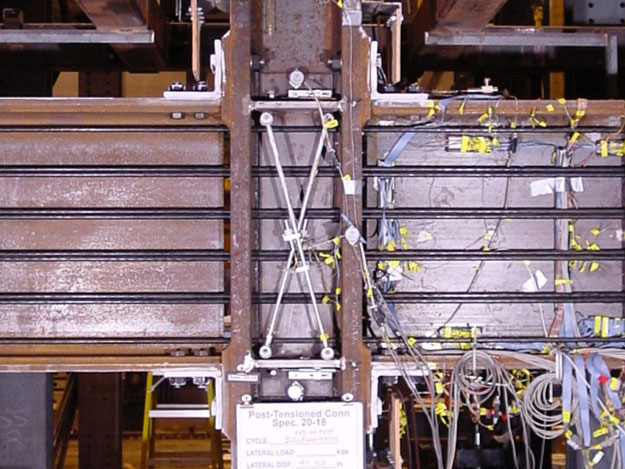
Current design practice for earthquake-resistant buildings produces systems that meet basic life safety requirements, but post-earthquake damage costs are enormous. For example, direct losses of more than $40 billion have been estimated for the 1994 Northridge earthquake in California, even though this earthquake was not large in magnitude. New earthquake- resistant structural systems that withstand design basis earthquake (DBE) ground motions without damage are clearly needed to reduce damage repair costs, and indirect economic costs due to loss of building occupancy. At the same time, to be utilized in the construction market, these new earthquake-resistant systems must be similar in initial cost to conventional systems. Self-centering (SC) steel frame systems have both characteristics: (1) the potential to withstand DBE ground motions without damage; and (2) the potential not to differ much in initial cost from conventional steel moment resisting frame (MRF) systems.
Partial List of References
- Herning, G., Garlock, M.E.M., Freidenburg, A. (2012). “Comparison of welded and post-tensioned steel moment-resisting frames”, Proceedings, Steel Structures in Seismic Areas (STESSA), Santiago, Chile, January.
- Herning, G., Garlock, M.E.M., Vanmarcke, E. (2011). “Reliability-based evaluation of design and performance of steel self-centering moment frames”, Journal of Constructional Steel Research, v 67, n 10, p 1495-1505.
- Garlock, M, and Li, J. (2008). “Steel Self-Centering Moment Frames with Collector Beam Floor Diaphragms”, Journal of Constructional Steel Research, Elsevier, v 64, n 5, p 526-538.
- Garlock, M, Ricles, J., and Sause, R. (2008) “Influence of Design Parameters on Seismic Response of Post-Tensioned Steel MRF Systems“, Engineering Structures, Elsevier, v 30, n 4, p 1037-1047.
- Garlock, M, Sause, R., and Ricles, J. (2007). “Behavior and Design of Post-Tensioned Steel Frames”, Journal of Structural Engineering, ASCE, v 133, n 3, p 389-399.
- Rojas, P., Garlock, M., Ricles, J.M., and Sause, R. (2005) “Use of Post-Tensioned Friction Damped Connections for Seismic Retrofit of Steel Moment Resisting Frames,” International Journal of Steel Structures, Korean Society of Steel Construction, v 5.
- Garlock, M, Ricles, J., and Sause, R. (2005) “Experimental Studies on Full-Scale Post-Tensioned Steel Connections”, Journal of Structural Engineering, ASCE, v 131, n 3, p 438-448.
- Billington, D., Garlock, M. (2004) “Thin Shell Concrete Structures: The Master Builders” Journal of the International Association for Shell and Spatial Structures, v 45, n 146, p 147-155.
- Garlock, M, Ricles, J., and Sause, R. (2003). “Cyclic Load Tests and Analysis of Bolted Top-and-Seat Angle Connections,” Journal of Structural Engineering, ASCE v 129, n 12, p 1615-1625.
- Ricles, J., Sause, R., Garlock, M., and Zhao, C. (2001). “Post-Tensioned Seismic Resistant Connections for Steel Frames,” Journal of Structural Engineering, ASCE, v127, n 2, p 113-121.
